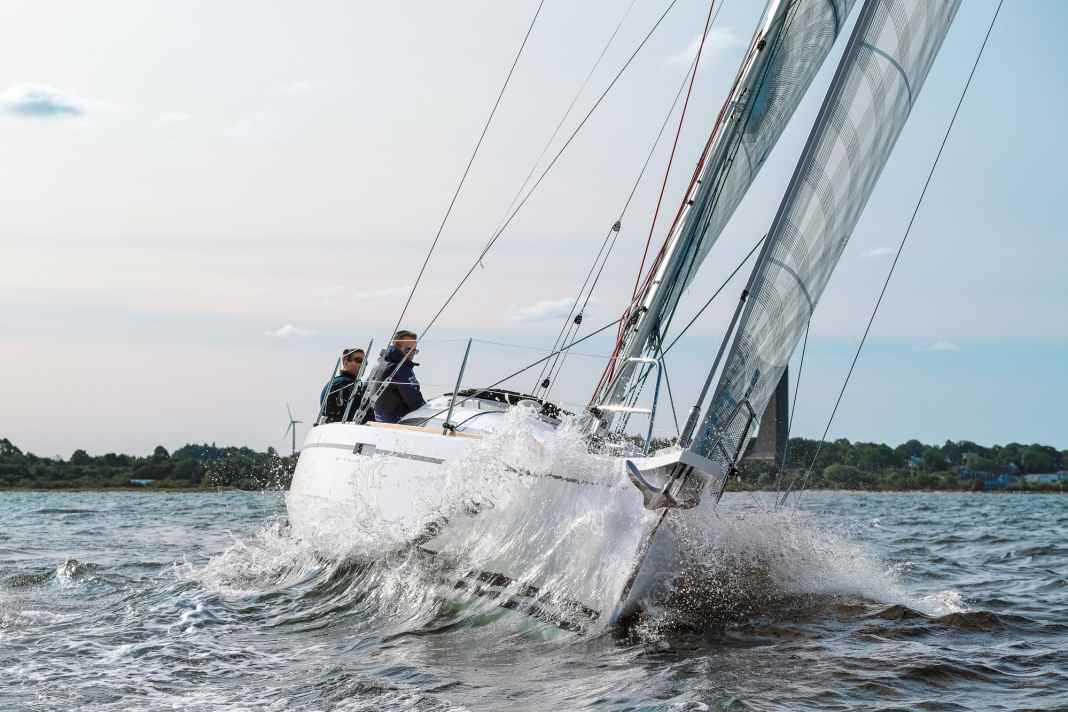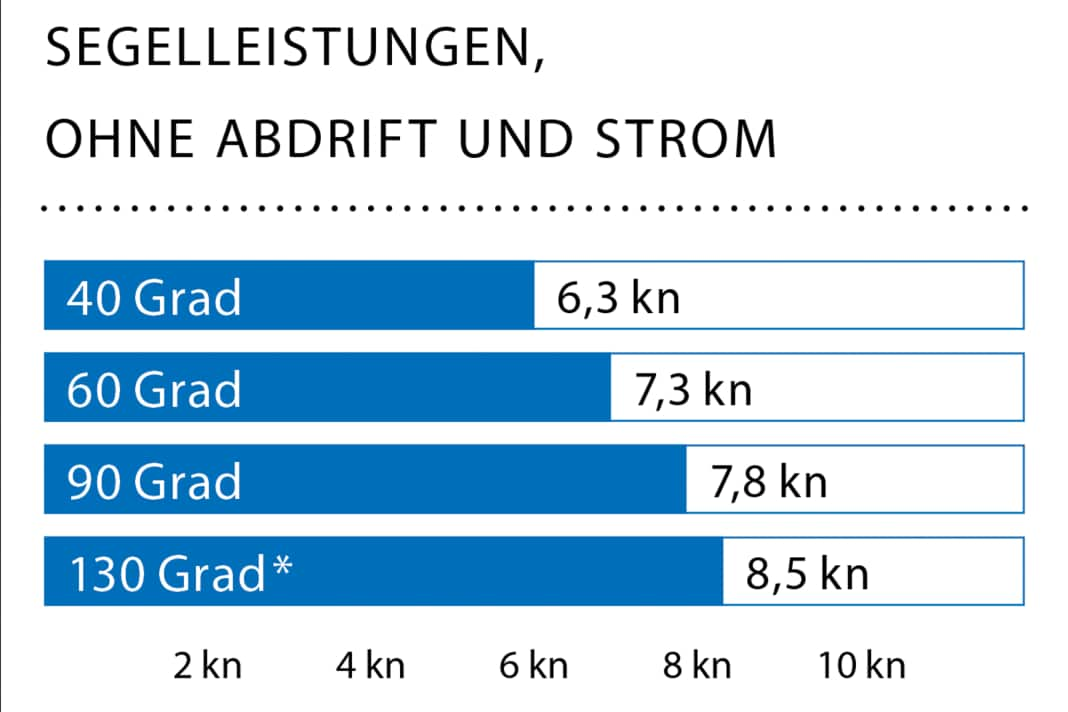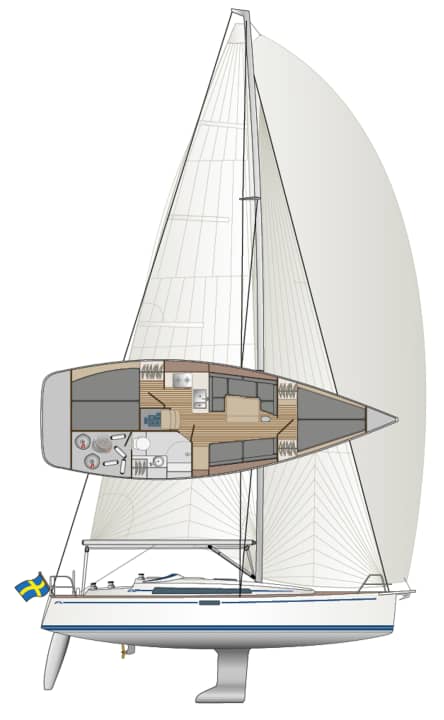





Amazing rating. Until a few years ago, shipyards were still quite active in the almost eleven metre long performance cruiser class and interested customers were able to enjoy models such as the Diva 34 SC and the Dehler 34, but things have become quieter for a while in this size segment of sporty yachts. Surprising, because the length of around 34 feet is ideal for a couple, but also works with family and guests, because you don't have to make any major compromises in terms of draught and, finally, because the maintenance costs remain reasonable. In addition, sporty boats of this size offer the potential, range of action and sea behaviour of much larger yachts that are designed purely as tourers.
The competition
Despite these positives, apart from Dehler, no large-scale shipyard currently offers a 34-foot performance cruiser. Dealers and customers alike are waiting for a First from Beneteau, Dufour has long since discontinued its more ambitious line, Jeanneau only offers hot boats in the form of very slimmed-down two-handed racers, Bavaria is also lacking, and X-Yachts does not currently build anything under 40 feet. The market for sporty ten-metre-plus yachts is shared by many smaller shipyards. Elan from Slovenia and J/Boats from the USA, which builds under licence in France, are among the larger players.
Grand Soleil and Italia Yachts are entering the segment. And various Scandinavians such as the aforementioned Diva, the older Linjett and the Arcona 345, which has now been completely renovated by the Swedish shipyard. The company, which is based just outside Stockholm in Gustavsberg, has its smaller units manufactured in Estonia by Luksusjaht, which produces on the island of Saaremaa, which can be categorised as the Baltic counterpart to the Swedish boatbuilding island of Orust. Arcona has five types in its programme, from the 345 to the carbon yacht 465.
Even more potential with the Arcona 345
For the new 345, the Swedes stuck with the tried-and-tested hull, which has been built around 60 times since 2009. The design by in-house designer Stefan Qviberg, who died in 2018, was reworked by Italian Maurizio Cossutti, who has often demonstrated a knack for modifying details and, in addition to his role as a designer for Bavaria Yachtbau, also works for shipyards such as Nautor's Swan, albeit more in the shadows.
One aim of the modernisation was to increase performance. The easiest way to achieve this with an existing hull is, of course, with more horsepower, i.e. sailcloth. The 345 has almost eight square metres more sail area thanks to a slightly larger genoa and surface optimisations in the mainsail. The comparatively low weight of 5.2 tonnes has remained. In combination, this generates a sail carrying capacity of a dimensionless 5.0 - which already makes it a proven performance cruiser. In addition to theoretical figures, there are tangible characteristics for this categorisation. The bomb is made of antimony-hardened lead, which used to be standard on sporty boats but is now the exception because it is much more expensive. This measure also has the advantage that lead is more forgiving of noticeable groundings because it absorbs the energy well. Or take the construction method: vacuum infusion with Divinycell foam as a sandwich core, and this also in the underwater hull, apart from areas at the keel and hull openings.
The Arcona 345 is designed for performance
The deck layout is also noticeably performance-cruiser, as can be seen at first glance during the test at the dealer AP Yachting in Laboe. Fat 46 rake winches for the headsails and Dyneema all round speak a clear language. The masthead spinnaker with barber haul and inhauler for the sheets of the 106 per cent genoa also speak for themselves. Plus optional German Sheeting System and double carbon wheels.
However, a tiller is standard, which would also look good on the boat. A nice detail in the stern: the backstay cascade is located in the centre and is not routed to both sides as is usually the case via a cockpit to make it easier to pass over the open stern. This frequently chosen measure often leads to bottlenecks for the helmsman, especially on boats of this size, if he is sitting on the side of the deck at the wheel. The drawback here, however, is that the clamp attached to the transom cannot be operated remotely. The stern is open, there is no bathing hatch.
A lot of lines means a lot of clamps, and on some boats, where halyards and stretchers run through pipes or shafts on the roof, things get tight: there is room for five lines per side, but not for more clamps and additional deflections. The Arcona is different: there is room for a whopping twelve lever clamps.
The shrouds are now on the outside with wide spreaders, which means that the tensile forces of the rig can be better transferred into the hull and onto the galvanised steel frame. Nevertheless, a 107 per cent genoa is still possible. The furler of the furling system is recessed in the anchor locker, so the genoa is lower on deck, which is more effective.
No chines, no edges, just straight lines
Despite all the modernisation measures, you can tell that the boat is not a contemporary design. This can also be seen in a positive light, as the Arcona still has an elegant, pleasing appearance and thus proves its timelessness: no chines, no negative bow, no upwardly retracted freeboards - but rather straight, sheer, harmonious lines and a hull that tapers towards the stern with a stern that is significantly narrower than the widest width.
She is tamer than many a new boat with an aggressive look. The Arcona sails as well as a modern ship, as she proved on the Kiel Fjord. With 4 Beaufort on the wind, she reached around 6.3 to 6.5 knots at a very good height despite a short, slowing wave; further into the fjord, a few tenths more could be achieved with fewer waves. The values are probably also due to the excellent standing sails from UK Sailmakers Germany, which were on board in the X-Drive Carbon version with taffeta coating on one side. As is usual on many performance cruisers, no sails are supplied as standard.
The boat parried gusty winds well, proving to be stiff and controlled thanks to the rather high ballast ratio, the shape of the frame and the deep bomb. The values soared upwards when sailing under the mainsheet, and speeds of more than 8 knots could easily be achieved even under the small furling gennaker. The boat steered comfortably and directly enough, although Jefa's pulley system was still a little tight. The sitting and standing positions on the 80-centimetre diameter wheels are excellent and trouble-free.
The Arcona 345 is fast, high and comfortable
The narrower stern not only makes for a better look. Two aft compartments are not even offered, leaving room for a large and deep forecastle. If the boat looks timeless on the outside, it has been completely modernised on the inside. The most striking feature is the optional surface design in limed oak. The light-coloured finish is also finding its way into Scandinavian shipyards thanks to shipyards such as Hallberg-Rassy, X-Yachts and Nautor. This raises the question of why the dark cave has been able to survive for years in countries with a particularly long and dark winter. However, the tried and tested reddish-brown mahogany interior remains standard on the Arcona 345.
The comfort dimensions are essentially okay. The headroom in the important areas such as the saloon (centre 1.85 metres) and toilet/shower room (1.84 metres) is sufficient for most people. At 1.74 metres in the foredeck, it is a little tight at best. However, the more important berth width, which is a pleasing 1.75 metres at shoulder height, is pleasing there, and the footwell is also large enough. Even the aft cabin is over 1.70 metres wide - great! The distance between the toilet and the cockpit edge is a little tight. And the transverse ventilation in the boat is also open to criticism: only a small superstructure window in the galley can be opened. Instead, there is a centre hatch and a pair of dorade vents on the cabin roof, which can provide permanent ventilation - a feature that is in danger of dying out.
Other conspicuous features below deck: The centre section of the strongback can only be reached from the sides without removing the entire floorboards, making it difficult to keep clean and dry. The cooker can hardly be used when the boat is positioned on the port bow, because the gimbal strikes. The foredeck offers plenty of space under the berth and there is no tank installed, which also benefits performance. A small, open oil locker is installed in the wet cell, and the forecastle locker can be reached from there. The finish and installations are upmarket, although not Champions League.
High standard, high price
Excellent sailing characteristics, extremely user-friendly deck layout, timeless look, well-built, various options - the Arcona 345 is without doubt a really good boat that anyone looking for a boat of this size and orientation should take a look at.
That leaves the question of price. Here, the ship is in a league of its own. Well equipped, it costs 300,000 euros, for which many a 38-footer can be purchased - and equipped. Head of Sales Magnus Lindgren puts things into perspective: "Yes, the price is high, but we also see ourselves as Hallberg-Rassy, we're just sportier." A comparison that may be valid.
The measured values for testing the Arcona 345




The Arcona 345 in detail

Technical data of the Arcona 345
- Design engineer:Qviberg/Cossutti
- Torso length:10,40 m
- Waterline length: 9,80 m
- Width: 3,45 m
- Draught/alternate:1,95/1,80, 2,15 m
- Weight:5,2 t
- Ballast/proportion:1,96 t/38 %
- Mainsail: 41,4 m2
- Furling genoa (107 %):33,5 m2
- machine (Yanmar):15 kW/21 hp
Hull and deck construction
Vacuum infusion process, sandwich with foam core, vinyl ester resin. Laminated bulkheads
Price and shipyard
- Base price ex shipyard:278.50o € gross
- Guarantee/against osmosis:2/5 years
As of 11/2023, how the prices shown are defined can be found here !
Shipyard
Arcona Yachts, Sweden, www.arconayachts.se
Distribution
AP Yachting, Laboe; 04343/494 02 93; www.apyachting.de
YACHT rating
Fast, pretty, great deck layout, appealing inside - the Arcona 345 is an alternative in the class of sporty ten-metre yachts, which is hardly served by large series yards any more
Design and concept
- + High-quality construction
- + Timeless lines
Sailing performance and trim
- + High performance potential
- + Well-functioning deck layout
Living and finishing quality
- + Clean interior fittings with options
- + Choice of dark or light-coloured interior
- - Bilge centre difficult to reach
Equipment and technology
- + Generous deck equipment
- + Centre backstay (seating position)
- - Backstay clamp difficult to operate
This article first appeared in YACHT 22/2020 and has been updated for this online version.

